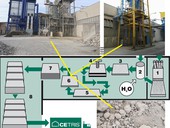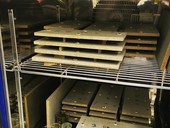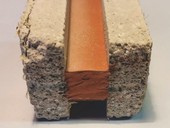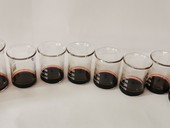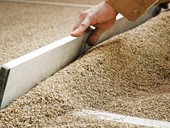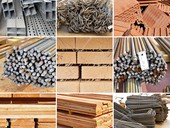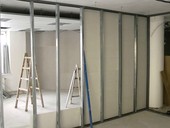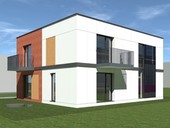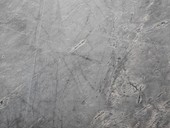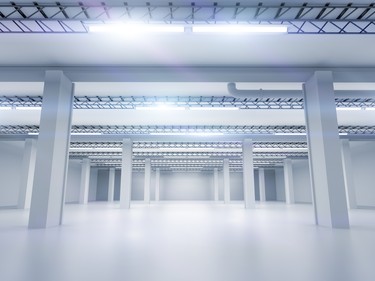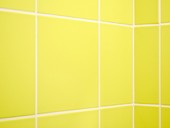The article presents research focused on a detailed analysis of cement-bonded particle boards modified with waste dust. This dust is produced during the grinding and cutting of cement-bonded particle boards. The emphasis was mainly placed on the behavior of boards with a modified composition with regard to their hygroscopicity and useful properties. The properties of three types of boards were analyzed – reference (Portland and blended cement) and dust-modified (filler and matrix – based on Portland and blended cement, substitution with waste dust in an amount of 8%). The boards were exposed to an environment with variable relative humidity (0% to 96%), with a gradient of increase and decrease of 10%. The output of this measurement is sorption curves. Subsequently, the mechanical properties (strength characteristics and modulus of elasticity) were tested on the test specimens. The obtained sorption isotherms confirmed the different behavior of individual composites in response to changes in ambient relative humidity. The results indicate that the composition of the mixture has a significant influence not only on sorption processes, but also on the stability of the wood filler itself, specifically spruce chips contained in the material. However, the behavior of the analyzed types of boards in terms of hygroscopicity is very similar. An increase in strength and modulus of elasticity was observed in all tested board variants. This finding is a positive sign for the further use of stabilized alternative raw materials in cement-bonded particle boards. The use of waste dust has significant potential to positively impact the environment, i.e., by consuming waste that would otherwise be a burden on the environment.
Archiv článků od 1.5.2020 do 15.12.2025
This article addresses the issue of the effect of moisture on the characteristic manifestations of plasterboard. It first summarizes the processes of plasterboard in fire. It then highlights the influence of fire-fighting water. Second, it describes an experiment carried out in which fire-degraded plasterboard samples were exposed to water. Their subsequent natural drying was also measured.
The fourth and last part of the series of articles on the problem of masonry buildings situated in floodplains deals with the problem of loading of buildings during the passage of a flood wave. Specifically, the calculation of the load from the vertical buoyancy of water from the flood wave, the load from the dynamic pressure and the load from the dynamic effect of a floating object.
The contribution summarizes the fundamental chapters of the transported standard to re-demolition audit and building dismantling as a standard procedure for structure removal. The purpose of the standard will be to prescribe how the pre-demolition audit should proceed, what information it should contain, and how the deconstruction of the building should take place, in order to achieve the maximum possible utilization of the obtained materials. The motivation is primarily the return of quality raw materials to production and the reduction of primary resource extraction, which is one of the goals of sustainable development.
In the presented paper, the results of the use of modified gypsum-based recyclate obtained from construction and demolition waste are analyzed. The selected recyclate comes from a real construction site of Moravostav Brno, a.s. and was subjected to modifications using a newly developed gypsum plasterboard recycling line. During the research, the influence of the recyclate treatment, especially in terms of grinding fineness, on the key properties of the dry gypsum mixture was monitored. Substitution of gypsum (or gypsum binder) in the mix was carried out in proportions of 10, 25 and 50 wt%. The resulting properties, such as bulk density, flexural tensile strength, compressive strength, volumetric changes and shrinkage, were monitored after 7 days of sample production.
In a follow-up step, gypsum blocks using treated gypsum recyclate and the designed dry gypsum slurry were semi-produced at Moravostav Brno, a.s. in January 2024. A segment of the wall was constructed from the blocks.
The results obtained clearly show that with appropriate treatment, it is possible to effectively replace part of the gypsum binder in the dry gypsum mixture using modified gypsum recyclate. These findings provide important information for the advanced use of gypsum plasterboard recycling in the construction industry, while highlighting the potential for more sustainable and environmentally friendly practices in building materials.
This paper presents research focused on studying the behaviour and properties of wood-cement composites under changes in relative humidity. The behaviour and the resulting changes in properties with variations in air (relative) humidity are significantly influenced by the chips contained. The chips are mineralised or stabilised during the manufacturing process. The by-product (particle mixture) from the production of cement-bonded particleboards, which was used to modify the composition of the composites, already contained mineralised spruce chips (i.e. stabilised properties and structure). The goal of the research was to study the sorption mechanisms in terms of dimensional and volumetric changes, including the assessment of the composite materials' performance properties (density, strength characteristics and modulus of elasticity). Thus, the influence of spruce chips stabilization in terms of different matrix compositions of the composites was also partially, indirectly analysed. Three variants of composites were tested - 2 types of reference (based on Portland and blended cement); 1 type with modification of the binder and filler with particle mixture produced during the production of cement particleboards (4% cement substitution, 4% substitution of primary chips). For the determination of each point of the sorption curves, the test bodies were always exposed to a given moisture content for a period of time to allow their mass to settle. The sorption isotherms indicate the different behaviour of the plates during the increase and decrease of the ambient air humidity. Differences were also observed in the case of hysteresis. The modification of the composition of the mixture for the production of cement-bonded particleboards has an effect, among other things, on the stabilisation of the spruce chips. The changes in physical and mechanical properties are practically negligible in terms of the practical use of the boards with modified composition.
Contemporary architecture often works with glass facades, roofs or even glass columns and beams. The problematic part of a glass structure design is usually a connection between the glass elements and the rest of structure. In order to achieve as much transparency as possible, various mechanical point fixing systems, adhesive connections and their combinations were developed. Although being widely used, the design procedure is mostly based on experiments. There is ongoing research at the Czech Technical University in Prague focusing on characteristics of an embedded laminated connection under various types of loads. Within the initial phase of experiments, small scale specimens consisting of different glass and foil types were tested. The experiments revealed the tensile, eccentric shear and compressive short-term load-bearing capacity of the connection and a dominant mode of failure. Data obtained from the tests are going to be used for further numerical simulations and a parametrical study.
The article deals with sealing of cement-based materials and tensile properties of the sealed joint. Aquapanel cement board was chosen as the base material, which was treated with a primer. Then two sealants were applied, one representative of acrylic and one of polyurethane sealants. After curing, the resulting test specimens were tested according to the valid European standard ČSN EN ISO 8340, which defines the parameters of the test specimen and subsequent test procedures. The evaluation of the test, which took place visually and with a caliper measurement, showed that only polyurethane sealant could be recommended for sealing Aquapanel. This putty, unlike acrylic putty, did not show any defects after the test, so it can be stated as suitable for sealing Aquapanel cement board.
Ukraine has a strong influence on prices and availability of some construction materials. Steel products are the most hit by the war. Rising prices of energies and fuels are influencing the prices of construction materials, too. These unfavourable conditions are seen not only by small investors, but also by municipalities when announcing public tenders. The original price that won the public tender usually rises during the project’s preparation phase and subsequent construction phase. The author of this article analyses the construction materials’ price developments during a period of several years. In the article you can find a pricing of a particular public tender by indicative prices of construction materials and work in different periods.
One of the very essential aspects to ensure adequate durability of composite materials that combine cementitious matrix and wood is the stabilization of the wood structure. Stabilization of the wood structure is particularly important in relation to the moisture effect on the wood-cement composite mechanical properties. Stabilization of the wood matrix is generally carried out by means of suitable types of additives. This paper deals with a detailed analysis of the influence of the wood-cement materials composition in relation to the effect of liquid water. Another essential area of the presented research is the analysing the ability of the modified matrix (by different types of industrial wastes) to fix sugars in the structure of the wood mass, with regard to the possible affecting the hydration process of the cement matrix.
Floor leveling materials have an irreplaceable place in the construction or reconstruction of buildings, especially in the construction of floors where the aim is to reduce the wet process in relation to the speed of completing. Various types of raw materials (expanded clay, aerated concrete, mineralised wood chips, etc.) are used for floor leveling materials. This paper presents research and development of a new type dry leveling floor material based on treated cuttings from cement-bonded particleboard processing. This leveling material is intended for reconstruction and even construction of new floors in buildings. Research and development takes into account the environmental situation, because approximately 5,000 t of cuttings is produced during the formatting of cement-bonded particleboard annualy. The intention of the research and development was to assess the properties and behaviour of the leveling material based on suitably modified cuttings from the production of cement-bonded particleboards. The composition of the cuttings was adjusted in a jaw crusher and subsequently, different variants of the leveling material were analysed in terms of particle size distribution, compressibility, confined compressive strength, water absorption and thermal conductivity coefficient. The properties of the developed material were also compared with the parameters of commonly commercially available leveling materials.
Producers and suppliers of construction materials are dealing with rising prices of raw materials, semi-finished products and lots of different types of products. Insecurity of input raw material supplies for production is on the rise as well. This is due to the concurrence of many unfavourable circumstances.
Plastics are now being directed primarily to healthcare, mainly for the production of protective aids against virus transmission. A large amount of plastics is used for disposable food containers or packaging of goods, which is now more than ever ordered online. The outage of production capacity of global plastics producers in the USA has the biggest impact on plastics prices. Lack of plastics in the US influences significantly the quantity of plastics available on European markets. The subsequent withdrawal of plastics from China and Europe significantly contributes to logistics complications. Insufficient capacity of transport ships, aircraft and rail transport makes delivery times longer.
Reduction or termination of production of some smelters in Europe, rising emission allowance prices, tariff restrictions and a shortage of metals from Asia are contributing to raise metal prices. It is seen on the London Metal Exchange.
Although the long-term bark beetle calamity is not at its end yet, foresters have succeeded in stopping it in many places in the Czech Republic. Logging of bark beetle timber is decreasing and its price increases. The increase is caused not only by the decrease in logging, but also by export of this timber abroad, particularly to China, which is a phenomenon of the last two years.
Pandemic restrictions have impact on availability of workers for materials production, products logistics, sale and on-site assembly. There was a slowdown in construction output in spring and summer 2020. However, a recovery phase has been seen recently and demand for many materials exceeds supply.
The paper deals with the issue of emerging defects and failures in the construction of industrial floors in relation to concrete technology. The effects of deficiencies in concrete recipes on the occurrence of defects or failures are described, as well as the effects of treatment of the finished structure, laying of concrete and methods of its compaction.
In modern building systems, sound insulation of walls is often made of multi-layer structures. This article deals with the acoustic operation of such structures and discusses the importance of proper implementation. It also warns against limited sound insulation at low frequencies, which is often not given enough attention. Software for calculating sound insulation - INSUL - was used to compare the acoustic behavior of structures and for simulations.
Floor construction is assessed within the thermal field by the heat transfer coefficient and surface temperatures, and in the acoustic field particularly from the point of view of airborne and impact soundproofing. When using ultra-light concrete for the construction of flooring there are unique parameters to consider. Within the contribution, the development occurred of an ultra-light concrete daub that achieved this minimal weight due to an aggregate product based on foam glass. This ultra-light concrete displays a very good ratio of mechanical performance to thermal insulation properties. As a result of these excellent thermal insulation properties, and the design of a concrete daub without joints, the formation of thermal bridges in floor construction can be eliminated.
Together with the professional journal Podlahy, we have prepared a new series, where the authors get acquainted with the basic standard ČSN 74 4505 Podlahy - Common provisions and subsequently with other standards that are important for the floor area, and also respond to comments from opponents and reviewers. The first part of the series describes the most important provisions of ČSN 74 4505 in an annotated form.
The newly developed jointing grout is designed not only for normal conditions, but also for environments with higher chemical stress. For this reason, one of the key endpoints was also a chemical resistance of the grout. The jointing grout is based on a polymer basis, in particular with epoxide binder used, and also hazardous wastes are used as fillers. As is well known, the epoxy thermosets are very resistant to inorganic acid solutions. However, they can be easily degraded by the action of organic solutions. Within this fact, the aggressive environments and their concentrations were selected and their influence on the developed grout was assessed. Specifically, the effect of action of 60% sulfuric acid, then the influence of the action of vapours of this acid (at a concentration of 96%) and immersion of 10% acetic acid solution were assessed. After exposure to these aggressive substances, the visual changes of the samples were assessed primarily. Colour change, blistering, cracking, flocculation, gloss change, etc. were monitoring. The influence on microstructure, change of bulk density and flexural and compressive strength of the polymer jointing grout materials was studied.
zpět na aktuální články
